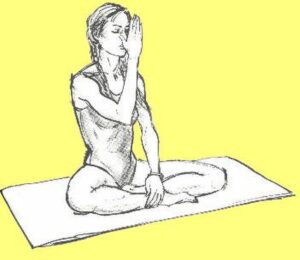 Alternate nostril breathing is a wonderful exercise that I will address in another post. This post on alternate nostril breathing will cover the fact that our two nostrils are working in different capacities at different times of the day.
Alternate nostril breathing is a wonderful exercise that I will address in another post. This post on alternate nostril breathing will cover the fact that our two nostrils are working in different capacities at different times of the day.
At all times during the day, we have a dominant nostril. You can feel this with no trouble at all by closing off one nostril and inhaling, and then closing off the other and doing the same. You should feel the nostril that is functioning more easily. And this workload will switch every two hours or so with the dominant nostril taking a backseat to the weaker one. And then two hours later they will switch again. You can check out a cool app on learning to breath here- Breathing Lessons.
This concept of our nostrils breathing in different rhythms has always fascinated me. There are numerous reasons why this happens. Our olfactory sense is one of them—at any given time one nostril does a better job identifying different smells depending on which one is dominant at that moment. Odd as it might sound some smells are easier to detect when breathing freely and more quickly while others are better distinguished through the more clogged nostril.
One of the aspects of walking correctly that I teach is that when our body works successfully half of the body gets to relax with each step that we take. With the natural function of alternated nostril breathing, one nostril gets a bit of a break as the other carries a fuller workload. This regular ebb and tide of effort and relaxation is essential to a healthy body.

The other day I wrote about chest breathing and its deleterious effect on our nervous system, particularly its ability to keep us stuck in the sympathetic nervous system. It is our autonomic nervous system, of which both the sympathetic (excitation) and parasympathetic (relaxation) nervous systems are a part, that controls the switching of this alternate nostril breathing.
Alternate Nostril Breathing and the Nervous System

Along with this rhythm of alternative nostril breathing we find that the brain alternates between hemispheres at relatively the same rate. These two rhythms correspond in an alternating pattern with the dominant right nostril working with the dominant left hemisphere. The right nostril is considered to be related to the sympathetic nervous system and the left connected to the parasympathetic nervous system.
The yogic breathing technique referred to as alternate nostril breathing, or nadi shodana, that I will write about soon, seeks to balance the left and right hemispheres of the brain and the energy channels known in yoga as the nadis.
A similar sense of balance and equilibrium is what I am trying teach people by showing them how to walk correctly. Balance across all planes of the body, mind and spirit is what we need to age gracefully which is all I really want to do.
